The night before we attended my brother’s college graduation ceremony to cheer on his record-setting 18 A+ grades and devoured fancy deep-dish pizzas to celebrate, our family bought tickets to attend our old high school band’s spring concert. Although I finished high school ages ago and my brother barely knew anyone in the ensemble too, we had a very special reason for going.
The new band director decided to create a slightly more modern program than the Tchaikovsky and Mozart my old director selected for us, which included six fun percussion-only pieces, as well as each of the three concert ensembles (freshman, regular, and elite) playing an electronic song.
For those new-age songs, the band performed a typical classical piece, while a laptop plugged into speakers played the accompanying electronic melodies. The director would press a tiny headphone into one ear while conducting the band, and he glanced offstage every so often to check in with the assistant director standing behind the computer.
Before the second ensemble began their electronic piece, a traditional song with the electronics added afterward, the band director called my younger brother up to the stage. My brother had actually composed the electronic accompaniment as a senior in high school, and the band had played it in a concert competition that year! He graciously spoke about how the band director had invited him to create the piece and explained his concept for the electronic sounds, and as the band played the song, both my mom and I were fighting back proud tears. (I’m actually crying now as I write this!)
Just like how my brother added a creative twist to a familiar song, I put a little spin on a classic flavor combo. Instead of the iconic muffins, I created these Lemon Poppy Seed Scones for my brother as the last installment of Lemon Week!
The scones’ flavor comes from both lemon juice and lemon zest. The latter provides the majority of the bright sunshiny taste. The oils in the lemon peel pack in quite a flavor punch, much more so than the juice, so don’t skip the zest! If you can find them, I recommend Meyer lemons because they’re slightly sweeter.
While traditional scone recipes require 1 or 2 sticks of butter (plus heavy cream) to keep them tender, these healthy ones use just 2 tablespoons! The rest of the moisture comes from Greek yogurt. It’s my secret weapon in healthier baking, and I’ve used it in everything from muffins to cupcakes to frosting. It provides the same moisture as additional butter or oil but without the excess calories. Greek yogurt also gives your baked goods a little protein boost!
Just before baking, we’ll slice the scone dough into 8 wedges and brush each with milk. The milk helps create their characteristic crusty exterior, which contrasts beautifully with the lovely tender texture on the inside.
Although it’s pure torture to sit around waiting for the buzzer to ding with the warm, lemony aroma wafting throughout the kitchen, I promise these scones are worth it! Paired with a cup of tea or iced coffee, they’re such a lovely sweet breakfast or snack.
And as for my brother’s opinion… I didn’t see a single crumb left!
| Lemon Poppy Seed Scones | | Print |
- 1 ½ cups (180g) white whole wheat or gluten-free* flour (measured correctly)
- 1 ½ tsp baking powder
- ½ tsp salt
- 4 tsp poppy seeds
- 1 tbsp lemon zest (about 1 medium lemon)
- 2 tbsp (28g) unsalted butter, cold and cubed
- ½ cup (120g) plain nonfat Greek yogurt
- 3 tbsp (45mL) agave
- 2 tbsp (30mL) lemon juice (about half of 1 medium lemon)
- 1 tsp vanilla extract
- 2 tsp nonfat milk
- Preheat the oven to 425°F, and line a baking sheet with a silicone baking mat or parchment paper.
- In a medium bowl, whisk together the flour, baking powder, salt, poppy seeds, and lemon zest. Cut in the butter with a pastry cutter or the back of a fork until the mixture resembles fine crumbs. Stir in the Greek yogurt, agave, lemon juice, and vanilla.
- Transfer the dough to the prepared baking sheet, and shape into a 1”-tall circle. Using a very sharp knife, cut the dough into 8 wedges. Brush the tops with the milk. Bake at 425°F for 16-19 minutes, or until the tops begin to turn golden. Cool on the baking sheet for 5 minutes before transferring to a wire rack.
For the gluten-free flour, I recommend as follows: 1 cup (120g) millet flour, ¼ cup (30g) tapioca flour, ¼ cup (30g) brown rice flour, and 1 teaspoon xanthan gum.
{gluten-free, clean eating, low fat, low calorie}
More lemon scone recipes from other food bloggers…
♥ Whole Wheat Blueberry Lemon Ginger Scones by The Lemon Bowl
♥ Lemon and Vanilla Bean Scones by Baked Bree
♥ Lemon & Cherry Whole Wheat Scones by Cookin’ Canuk
♥ Strawberry Lemon Scones with Lemon Glaze by Keepin’ It Kind
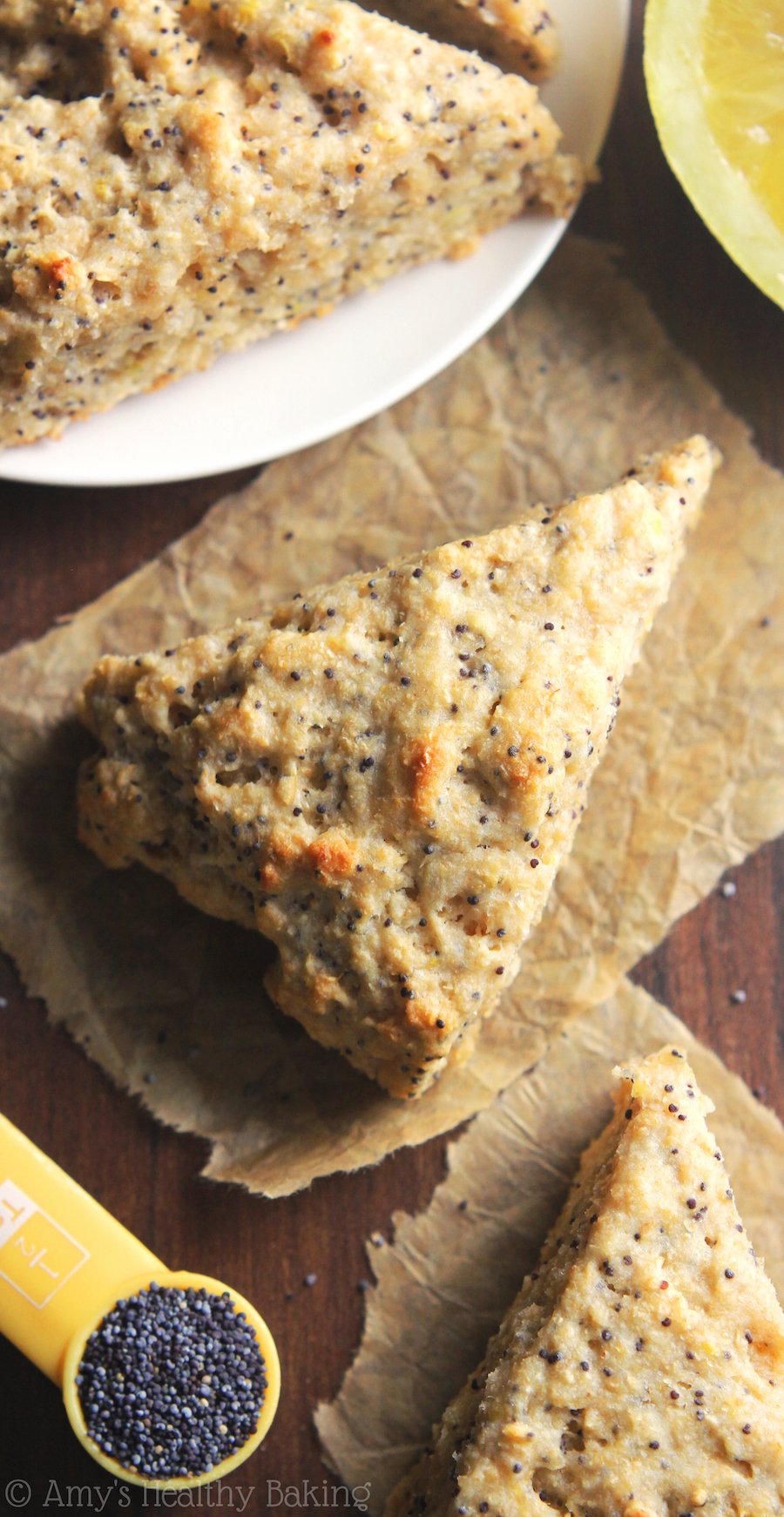

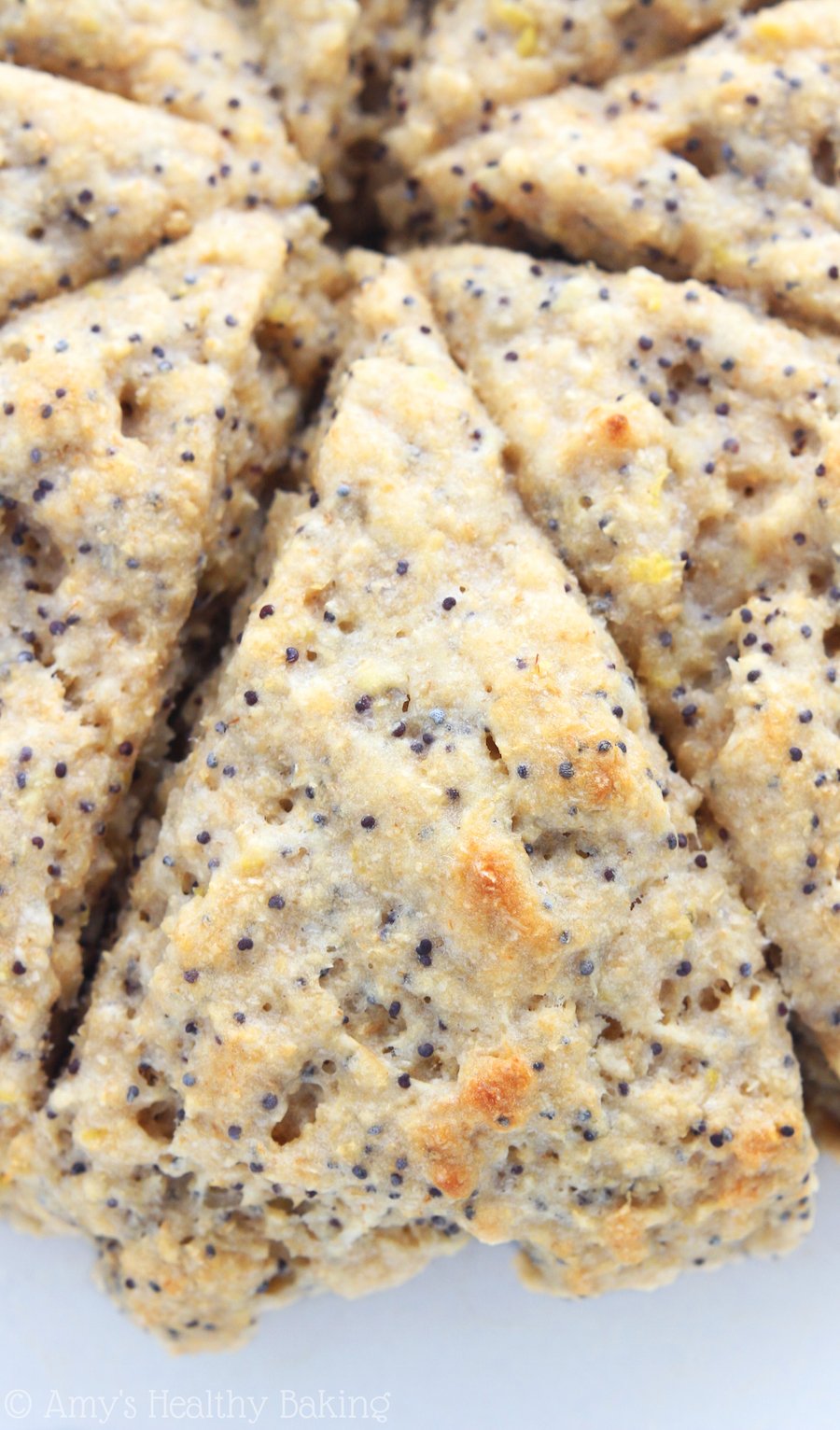

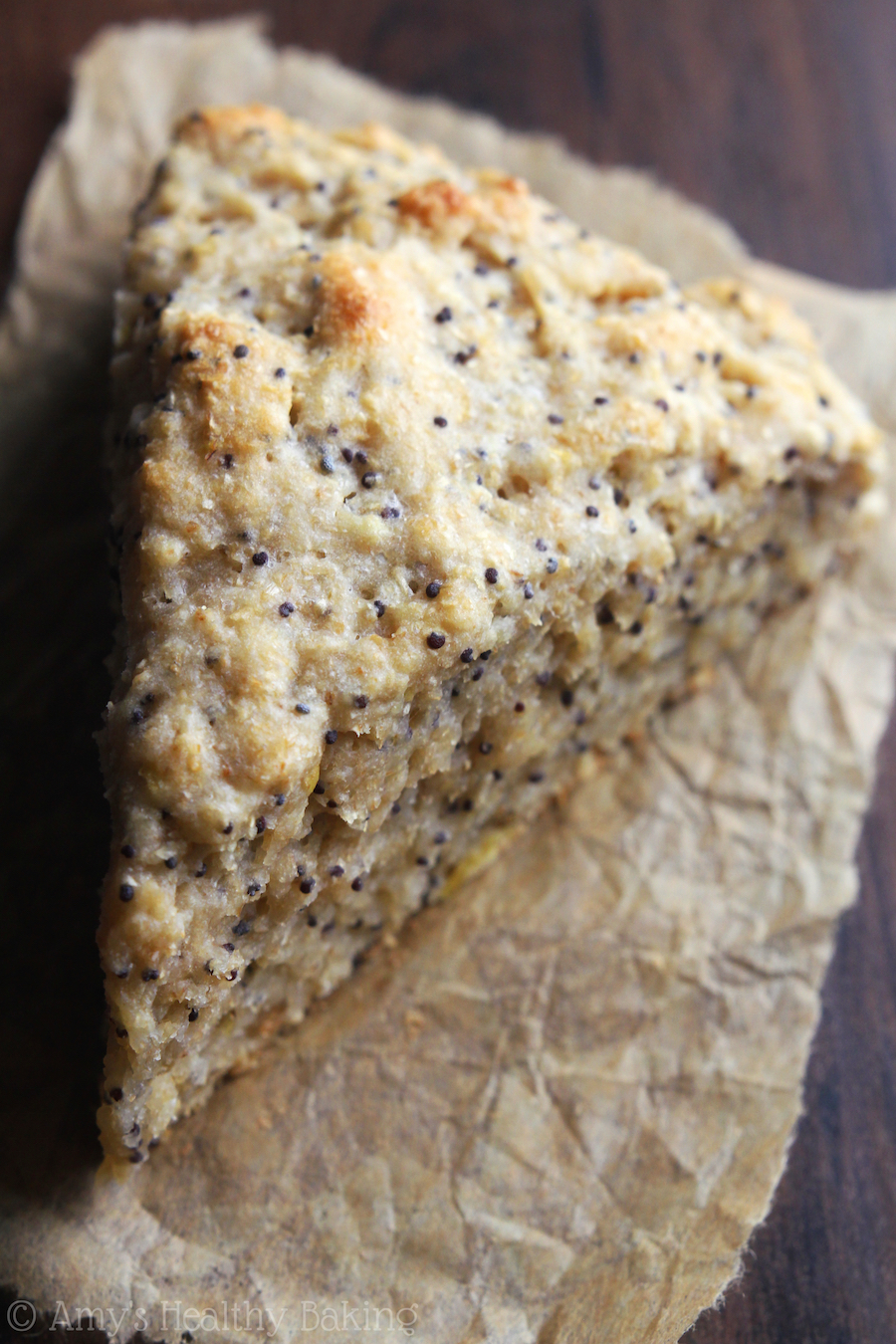
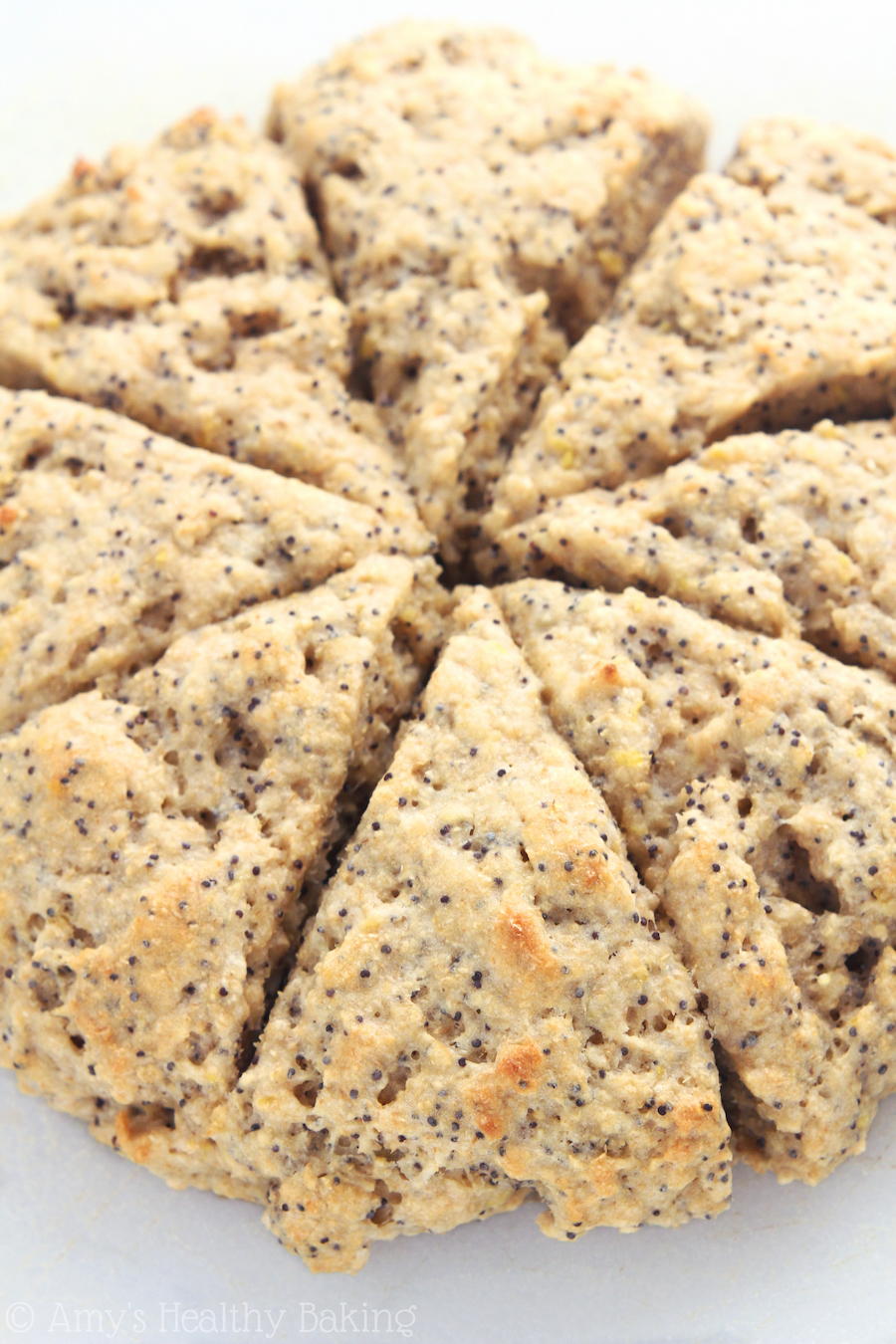
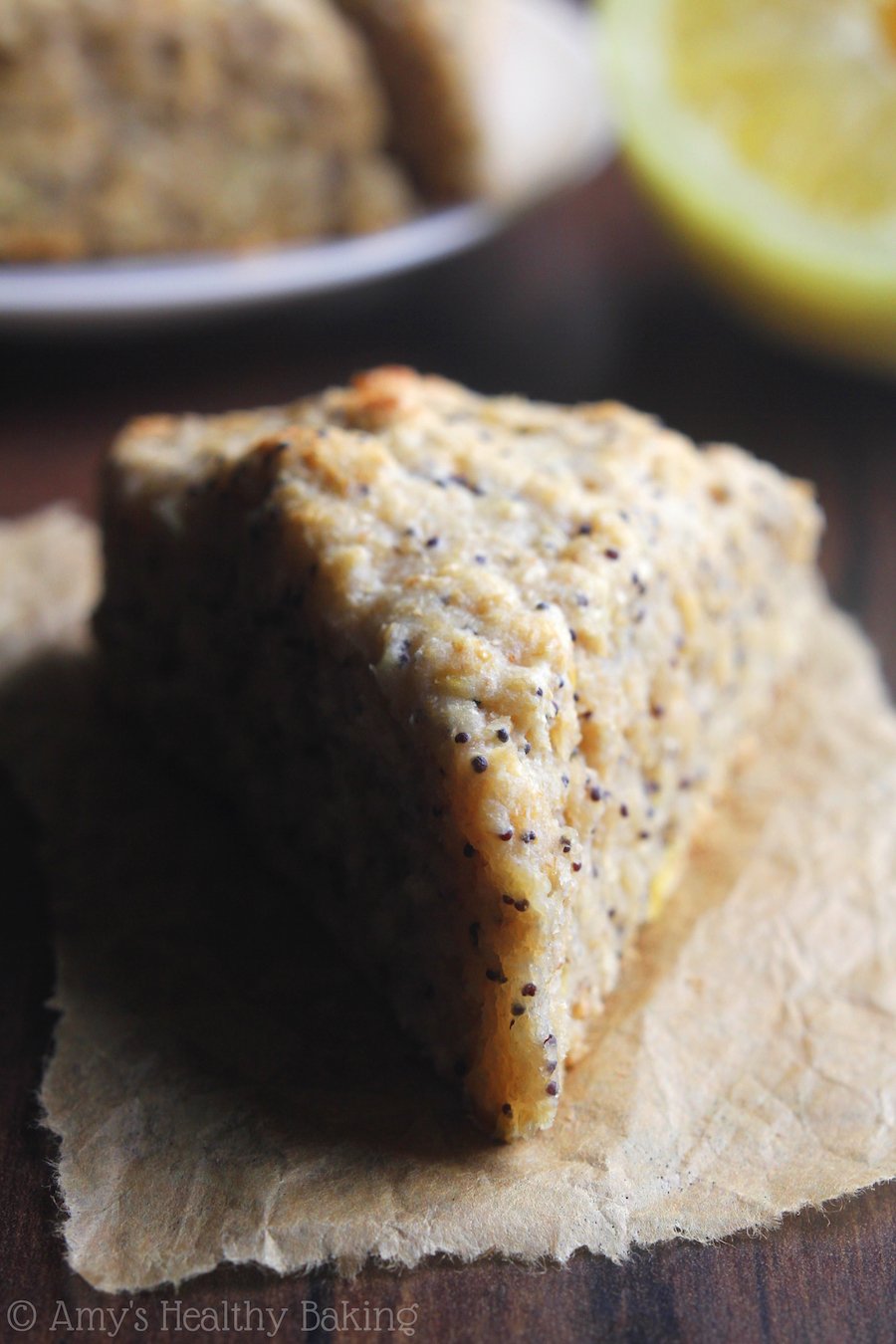


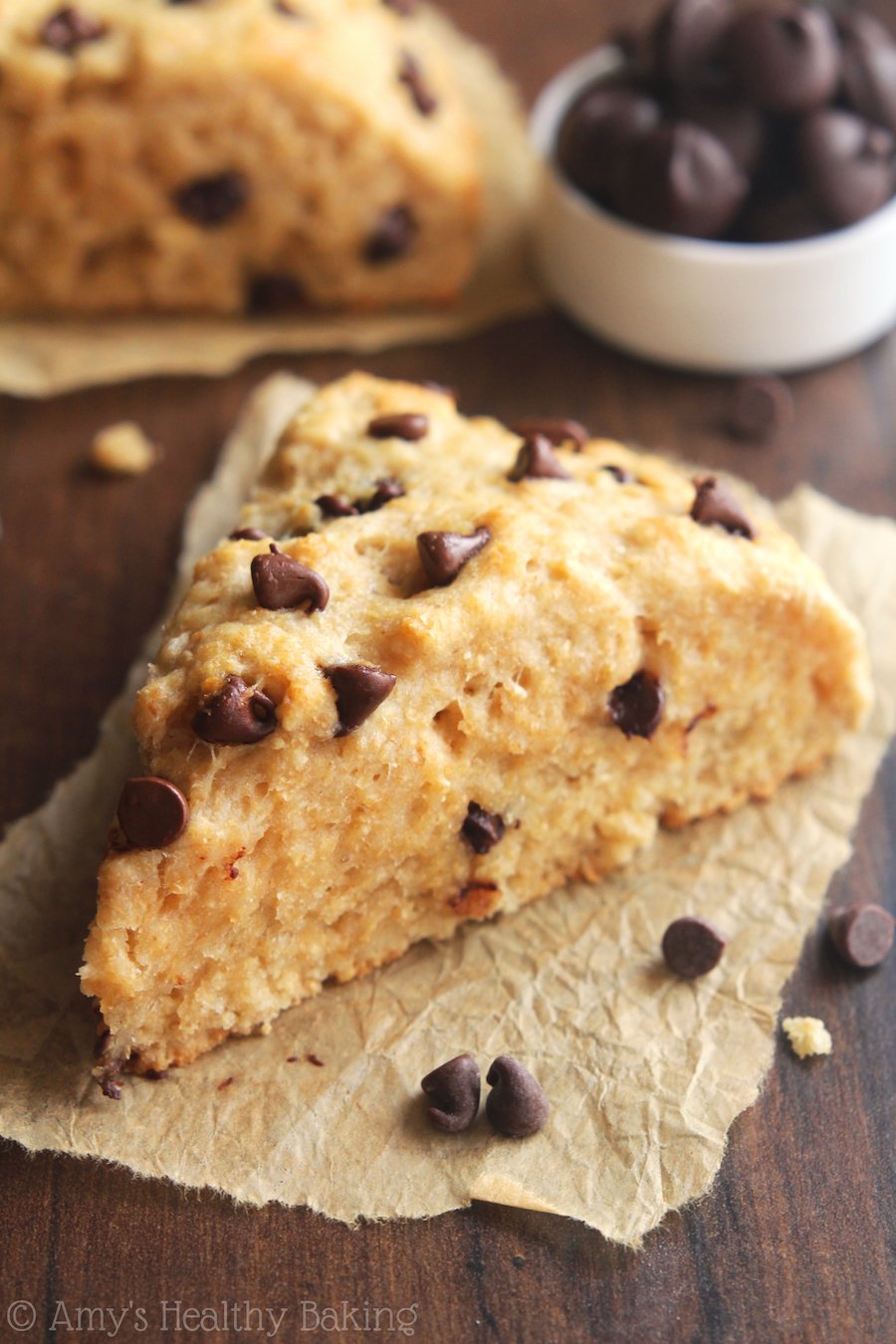
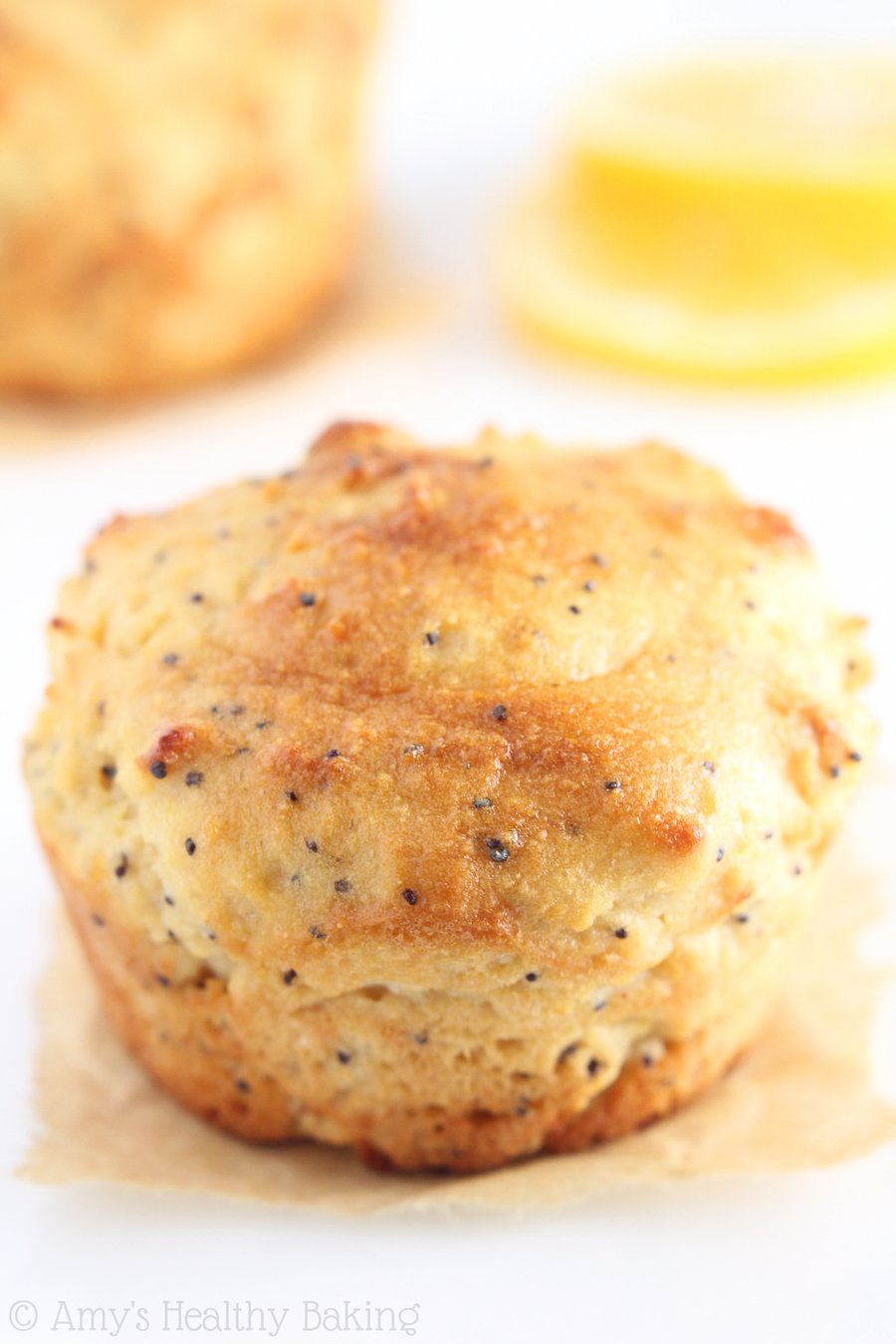

The photos were amazing, but I tried this recipe twice perfectly, once with Namaste gluten free flour mix and once with whole wheat flour and both turned out TERRIBLE. They are not even really edible and look nothing like the photo. Am I missing something? Did the recipe leave something out? Pretty upset that I wasted my time and ingredients on these scones.
I really appreciate your interest in my recipe Lori! Let’s get this sorted out. 🙂 Can you describe the issues you experienced in a bit more detail? Also, how did you measure both of the flours — with measuring cups or a kitchen scale? If the former, can you describe in detail how you measured? What kind of lemons did you use? Your answers will really help us figure out what happened!
Hi Amy! Your recipes look fabulous! Quick question…on the lemon poppy seed scones, what could be substituted for agave? Agave is hard on my intestines. Thank you for all your help and keep up the great work! Blessings, Suzy
I really appreciate your interest in my recipe Suzy! I’ve actually answered this already in the Notes section underneath the Instructions. It can be easy to miss! 😉 I’d love to hear what you think if you try these scones!
Made these tonight, used whole wheat flour, coconut yogurt, no vanilla and three TBSP of lemon juice instead. Also added two tbsp of almond milk to the liquid.
Brushed the tops with melted vegan spread and a little coconut sugar and they were SO GOOD we devoured two right away.
I’m so glad you enjoyed these scones Lindsay! That means a lot to me! 🙂 Thanks for sharing your recipe modifications — I always love hearing what tweaks work!
I baked these at 425 and the tops started almost burning and the I wasn’t even half done. I followed everything exactly except for replacing the agave with honey. I lowered the temperature because I didn’t want them to be completely destroyed and they’ve still not fully cooked even after 25 minutes. I’m a caterer so I have experience in the kitchen. Not sure why this isn’t worked out at all
I really appreciate your interest in my recipe Ameira! That shouldn’t be happening, so I’d love to work together to solve those issues. 🙂 How thick was your disc of scone dough before you sliced it into segments and baked it? Where was your rack positioned in the oven? Was it in the top half, the middle, or the bottom half? Lastly, do you have an electric, gas, or convection oven? We’ll sort this out so your next batch of scones turns out much better!
Followed the recipe as cited, but the scones did not rise. Could that be caused by coconut yogurt (dairy free) used instead of Greek yogurt?
Thanks!
I really appreciate your interest in my recipe Evelyne! These scones actually aren’t supposed to rise too much, only about ¼” or so. The coconut yogurt should be fine! How did you measure the flour — with measuring cups or a kitchen scale? If the former, can you describe in detail how you did that? Also, do you know the variety of lemons you used? Were they regular, plain lemons from the grocery store, or were they Meyer lemons? We should be able to get your scones to rise a bit more once I know the answers to those questions! 🙂
These were delicious! The amount of lemon was perfect and they smelled so good while they were cooking!
I’m so glad you enjoyed these scones, Kally! It truly means a lot that you tried two of my scone recipes on the same day. That’s such a huge compliment — thank you for taking the time to let me know!! 🙂
I’m wondering if I can use vegan “butter” for these. I’d like to make them for my office and one of my co-workers is vegan. I’ve never used it in baking products before. I know it has a different texture and is softer. I was thinking I’d freeze the “butter,” then grate it before adding it. Then I’d chill the scones for an hour or so. Because of the softer texture, I’m thinking I need to have it very cold before popping them into the oven.
Yes, absolutely! Stick-style vegan butter will work about as well as unsalted butter, and you shouldn’t have to make any major recipe modifications. I’d love to hear what you and your coworkers think of these scones if you try making them — and you’re so thoughtful to “veganize” them so your vegan coworker can have them too, Angelique! 🙂